Jiaxin Deng
OneRec-V2 Technical Report
Aug 28, 2025Abstract:Recent breakthroughs in generative AI have transformed recommender systems through end-to-end generation. OneRec reformulates recommendation as an autoregressive generation task, achieving high Model FLOPs Utilization. While OneRec-V1 has shown significant empirical success in real-world deployment, two critical challenges hinder its scalability and performance: (1) inefficient computational allocation where 97.66% of resources are consumed by sequence encoding rather than generation, and (2) limitations in reinforcement learning relying solely on reward models. To address these challenges, we propose OneRec-V2, featuring: (1) Lazy Decoder-Only Architecture: Eliminates encoder bottlenecks, reducing total computation by 94% and training resources by 90%, enabling successful scaling to 8B parameters. (2) Preference Alignment with Real-World User Interactions: Incorporates Duration-Aware Reward Shaping and Adaptive Ratio Clipping to better align with user preferences using real-world feedback. Extensive A/B tests on Kuaishou demonstrate OneRec-V2's effectiveness, improving App Stay Time by 0.467%/0.741% while balancing multi-objective recommendations. This work advances generative recommendation scalability and alignment with real-world feedback, representing a step forward in the development of end-to-end recommender systems.
OneRec Technical Report
Jun 16, 2025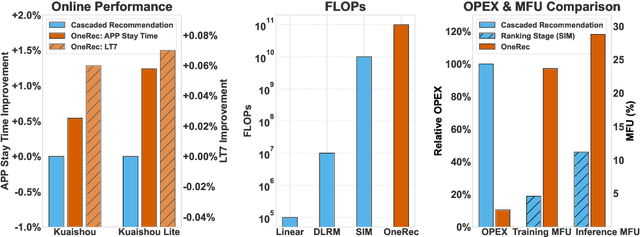

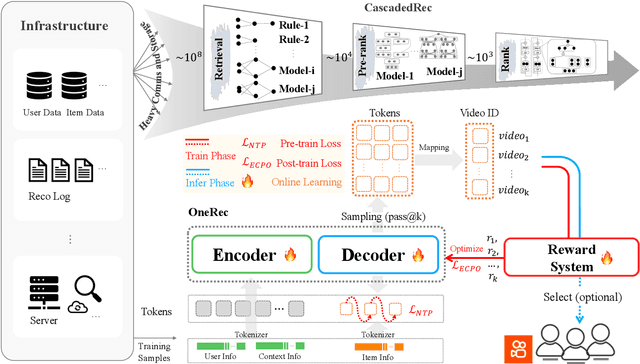

Abstract:Recommender systems have been widely used in various large-scale user-oriented platforms for many years. However, compared to the rapid developments in the AI community, recommendation systems have not achieved a breakthrough in recent years. For instance, they still rely on a multi-stage cascaded architecture rather than an end-to-end approach, leading to computational fragmentation and optimization inconsistencies, and hindering the effective application of key breakthrough technologies from the AI community in recommendation scenarios. To address these issues, we propose OneRec, which reshapes the recommendation system through an end-to-end generative approach and achieves promising results. Firstly, we have enhanced the computational FLOPs of the current recommendation model by 10 $\times$ and have identified the scaling laws for recommendations within certain boundaries. Secondly, reinforcement learning techniques, previously difficult to apply for optimizing recommendations, show significant potential in this framework. Lastly, through infrastructure optimizations, we have achieved 23.7% and 28.8% Model FLOPs Utilization (MFU) on flagship GPUs during training and inference, respectively, aligning closely with the LLM community. This architecture significantly reduces communication and storage overhead, resulting in operating expense that is only 10.6% of traditional recommendation pipelines. Deployed in Kuaishou/Kuaishou Lite APP, it handles 25% of total queries per second, enhancing overall App Stay Time by 0.54% and 1.24%, respectively. Additionally, we have observed significant increases in metrics such as 7-day Lifetime, which is a crucial indicator of recommendation experience. We also provide practical lessons and insights derived from developing, optimizing, and maintaining a production-scale recommendation system with significant real-world impact.
Other Vehicle Trajectories Are Also Needed: A Driving World Model Unifies Ego-Other Vehicle Trajectories in Video Latant Space
Mar 12, 2025Abstract:Advanced end-to-end autonomous driving systems predict other vehicles' motions and plan ego vehicle's trajectory. The world model that can foresee the outcome of the trajectory has been used to evaluate the end-to-end autonomous driving system. However, existing world models predominantly emphasize the trajectory of the ego vehicle and leave other vehicles uncontrollable. This limitation hinders their ability to realistically simulate the interaction between the ego vehicle and the driving scenario. In addition, it remains a challenge to match multiple trajectories with each vehicle in the video to control the video generation. To address above issues, a driving \textbf{W}orld \textbf{M}odel named EOT-WM is proposed in this paper, unifying \textbf{E}go-\textbf{O}ther vehicle \textbf{T}rajectories in videos. Specifically, we first project ego and other vehicle trajectories in the BEV space into the image coordinate to match each trajectory with its corresponding vehicle in the video. Then, trajectory videos are encoded by the Spatial-Temporal Variational Auto Encoder to align with driving video latents spatially and temporally in the unified visual space. A trajectory-injected diffusion Transformer is further designed to denoise the noisy video latents for video generation with the guidance of ego-other vehicle trajectories. In addition, we propose a metric based on control latent similarity to evaluate the controllability of trajectories. Extensive experiments are conducted on the nuScenes dataset, and the proposed model outperforms the state-of-the-art method by 30\% in FID and 55\% in FVD. The model can also predict unseen driving scenes with self-produced trajectories.
OneRec: Unifying Retrieve and Rank with Generative Recommender and Iterative Preference Alignment
Feb 26, 2025



Abstract:Recently, generative retrieval-based recommendation systems have emerged as a promising paradigm. However, most modern recommender systems adopt a retrieve-and-rank strategy, where the generative model functions only as a selector during the retrieval stage. In this paper, we propose OneRec, which replaces the cascaded learning framework with a unified generative model. To the best of our knowledge, this is the first end-to-end generative model that significantly surpasses current complex and well-designed recommender systems in real-world scenarios. Specifically, OneRec includes: 1) an encoder-decoder structure, which encodes the user's historical behavior sequences and gradually decodes the videos that the user may be interested in. We adopt sparse Mixture-of-Experts (MoE) to scale model capacity without proportionally increasing computational FLOPs. 2) a session-wise generation approach. In contrast to traditional next-item prediction, we propose a session-wise generation, which is more elegant and contextually coherent than point-by-point generation that relies on hand-crafted rules to properly combine the generated results. 3) an Iterative Preference Alignment module combined with Direct Preference Optimization (DPO) to enhance the quality of the generated results. Unlike DPO in NLP, a recommendation system typically has only one opportunity to display results for each user's browsing request, making it impossible to obtain positive and negative samples simultaneously. To address this limitation, We design a reward model to simulate user generation and customize the sampling strategy. Extensive experiments have demonstrated that a limited number of DPO samples can align user interest preferences and significantly improve the quality of generated results. We deployed OneRec in the main scene of Kuaishou, achieving a 1.6\% increase in watch-time, which is a substantial improvement.
Unsupervised Abnormal Stop Detection for Long Distance Coaches with Low-Frequency GPS
Nov 07, 2024Abstract:In our urban life, long distance coaches supply a convenient yet economic approach to the transportation of the public. One notable problem is to discover the abnormal stop of the coaches due to the important reason, i.e., illegal pick up on the way which possibly endangers the safety of passengers. It has become a pressing issue to detect the coach abnormal stop with low-quality GPS. In this paper, we propose an unsupervised method that helps transportation managers to efficiently discover the Abnormal Stop Detection (ASD) for long distance coaches. Concretely, our method converts the ASD problem into an unsupervised clustering framework in which both the normal stop and the abnormal one are decomposed. Firstly, we propose a stop duration model for the low frequency GPS based on the assumption that a coach changes speed approximately in a linear approach. Secondly, we strip the abnormal stops from the normal stop points by the low rank assumption. The proposed method is conceptually simple yet efficient, by leveraging low rank assumption to handle normal stop points, our approach enables domain experts to discover the ASD for coaches, from a case study motivated by traffic managers. Datset and code are publicly available at: https://github.com/pangjunbiao/IPPs.
ELASTIC: Efficient Linear Attention for Sequential Interest Compression
Aug 20, 2024



Abstract:State-of-the-art sequential recommendation models heavily rely on transformer's attention mechanism. However, the quadratic computational and memory complexities of self attention have limited its scalability for modeling users' long range behaviour sequences. To address this problem, we propose ELASTIC, an Efficient Linear Attention for SequenTial Interest Compression, requiring only linear time complexity and decoupling model capacity from computational cost. Specifically, ELASTIC introduces a fixed length interest experts with linear dispatcher attention mechanism which compresses the long-term behaviour sequences to a significantly more compact representation which reduces up to 90% GPU memory usage with x2.7 inference speed up. The proposed linear dispatcher attention mechanism significantly reduces the quadratic complexity and makes the model feasible for adequately modeling extremely long sequences. Moreover, in order to retain the capacity for modeling various user interests, ELASTIC initializes a vast learnable interest memory bank and sparsely retrieves compressed user's interests from the memory with a negligible computational overhead. The proposed interest memory retrieval technique significantly expands the cardinality of available interest space while keeping the same computational cost, thereby striking a trade-off between recommendation accuracy and efficiency. To validate the effectiveness of our proposed ELASTIC, we conduct extensive experiments on various public datasets and compare it with several strong sequential recommenders. Experimental results demonstrate that ELASTIC consistently outperforms baselines by a significant margin and also highlight the computational efficiency of ELASTIC when modeling long sequences. We will make our implementation code publicly available.
MMBee: Live Streaming Gift-Sending Recommendations via Multi-Modal Fusion and Behaviour Expansion
Jun 15, 2024Abstract:Live streaming services are becoming increasingly popular due to real-time interactions and entertainment. Viewers can chat and send comments or virtual gifts to express their preferences for the streamers. Accurately modeling the gifting interaction not only enhances users' experience but also increases streamers' revenue. Previous studies on live streaming gifting prediction treat this task as a conventional recommendation problem, and model users' preferences using categorical data and observed historical behaviors. However, it is challenging to precisely describe the real-time content changes in live streaming using limited categorical information. Moreover, due to the sparsity of gifting behaviors, capturing the preferences and intentions of users is quite difficult. In this work, we propose MMBee based on real-time Multi-Modal Fusion and Behaviour Expansion to address these issues. Specifically, we first present a Multi-modal Fusion Module with Learnable Query (MFQ) to perceive the dynamic content of streaming segments and process complex multi-modal interactions, including images, text comments and speech. To alleviate the sparsity issue of gifting behaviors, we present a novel Graph-guided Interest Expansion (GIE) approach that learns both user and streamer representations on large-scale gifting graphs with multi-modal attributes. Comprehensive experiment results show that MMBee achieves significant performance improvements on both public datasets and Kuaishou real-world streaming datasets and the effectiveness has been further validated through online A/B experiments. MMBee has been deployed and is serving hundreds of millions of users at Kuaishou.
Asymptotic Unbiased Sample Sampling to Speed Up Sharpness-Aware Minimization
Jun 12, 2024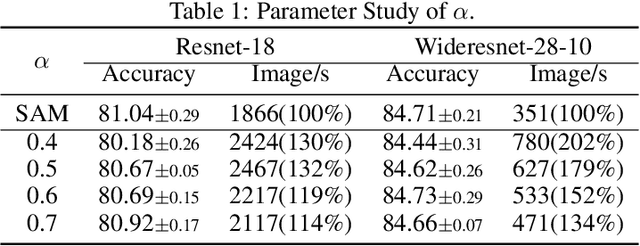
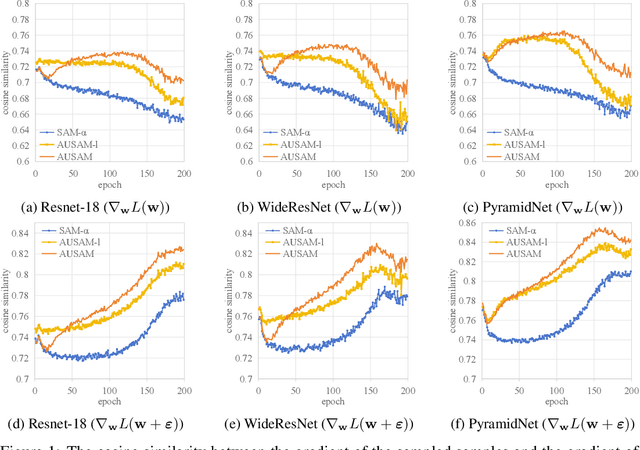
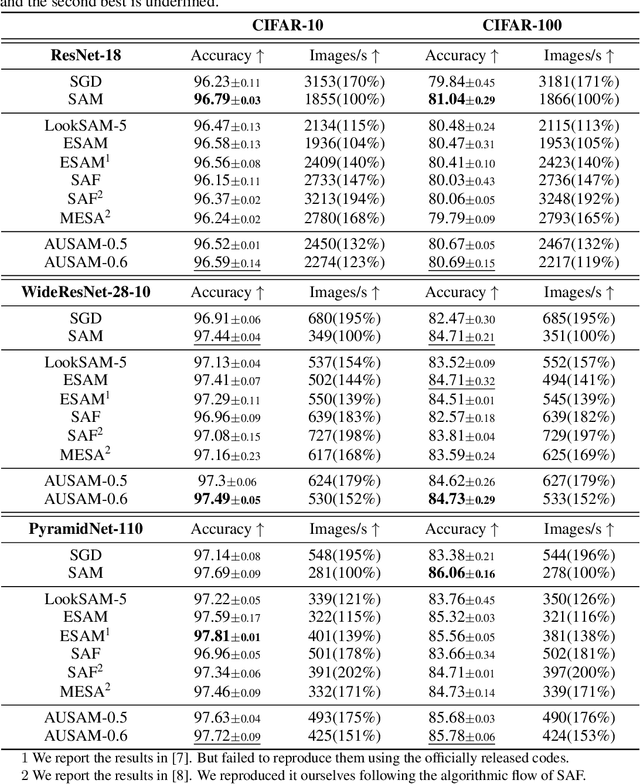

Abstract:Sharpness-Aware Minimization (SAM) has emerged as a promising approach for effectively reducing the generalization error. However, SAM incurs twice the computational cost compared to base optimizer (e.g., SGD). We propose Asymptotic Unbiased Sampling with respect to iterations to accelerate SAM (AUSAM), which maintains the model's generalization capacity while significantly enhancing computational efficiency. Concretely, we probabilistically sample a subset of data points beneficial for SAM optimization based on a theoretically guaranteed criterion, i.e., the Gradient Norm of each Sample (GNS). We further approximate the GNS by the difference in loss values before and after perturbation in SAM. As a plug-and-play, architecture-agnostic method, our approach consistently accelerates SAM across a range of tasks and networks, i.e., classification, human pose estimation and network quantization. On CIFAR10/100 and Tiny-ImageNet, AUSAM achieves results comparable to SAM while providing a speedup of over 70%. Compared to recent dynamic data pruning methods, AUSAM is better suited for SAM and excels in maintaining performance. Additionally, AUSAM accelerates optimization in human pose estimation and model quantization without sacrificing performance, demonstrating its broad practicality.
Pixel-Wise Symbol Spotting via Progressive Points Location for Parsing CAD Images
Apr 17, 2024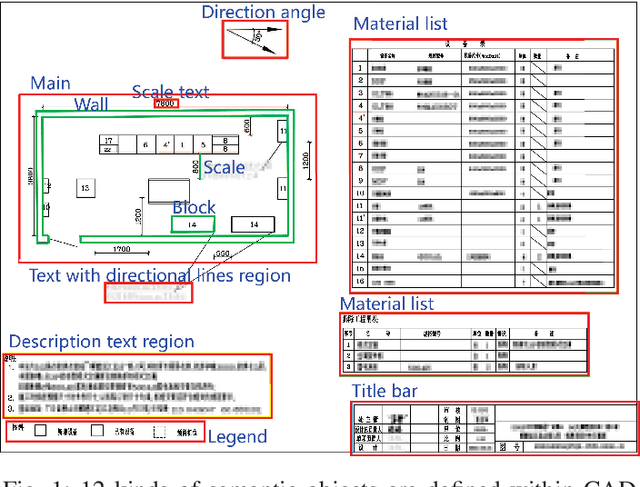
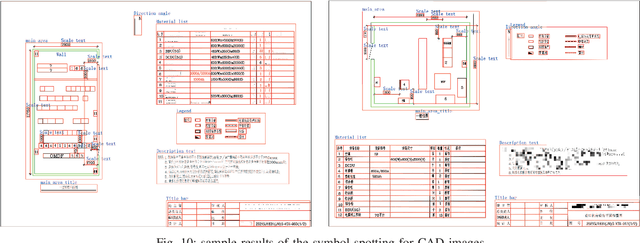
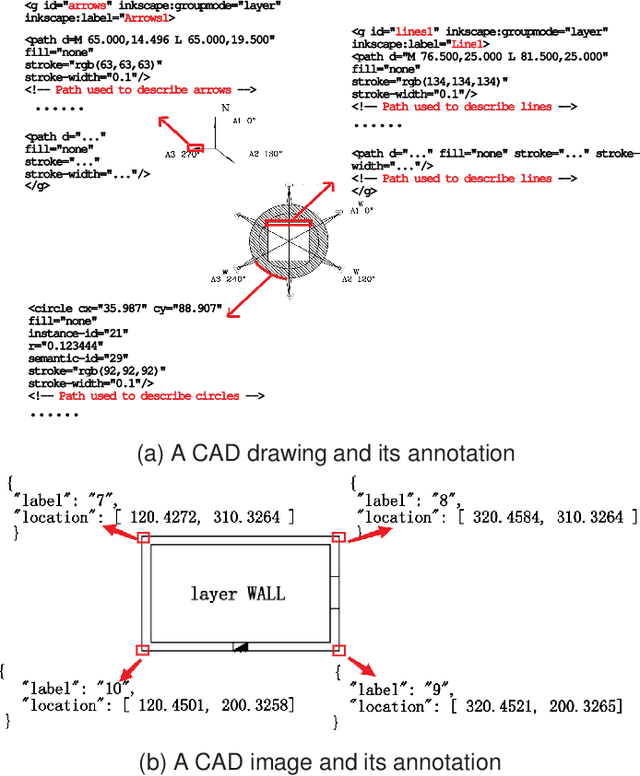
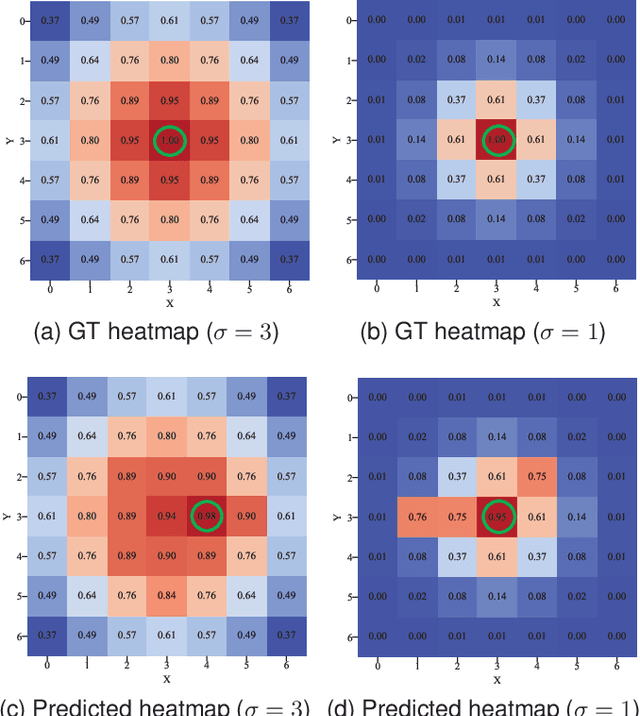
Abstract:Parsing Computer-Aided Design (CAD) drawings is a fundamental step for CAD revision, semantic-based management, and the generation of 3D prototypes in both the architecture and engineering industries. Labeling symbols from a CAD drawing is a challenging yet notorious task from a practical point of view. In this work, we propose to label and spot symbols from CAD images that are converted from CAD drawings. The advantage of spotting symbols from CAD images lies in the low requirement of labelers and the low-cost annotation. However, pixel-wise spotting symbols from CAD images is challenging work. We propose a pixel-wise point location via Progressive Gaussian Kernels (PGK) to balance between training efficiency and location accuracy. Besides, we introduce a local offset to the heatmap-based point location method. Based on the keypoints detection, we propose a symbol grouping method to redraw the rectangle symbols in CAD images. We have released a dataset containing CAD images of equipment rooms from telecommunication industrial CAD drawings. Extensive experiments on this real-world dataset show that the proposed method has good generalization ability.
ContentCTR: Frame-level Live Streaming Click-Through Rate Prediction with Multimodal Transformer
Jun 26, 2023Abstract:In recent years, live streaming platforms have gained immense popularity as they allow users to broadcast their videos and interact in real-time with hosts and peers. Due to the dynamic changes of live content, accurate recommendation models are crucial for enhancing user experience. However, most previous works treat the live as a whole item and explore the Click-through-Rate (CTR) prediction framework on item-level, neglecting that the dynamic changes that occur even within the same live room. In this paper, we proposed a ContentCTR model that leverages multimodal transformer for frame-level CTR prediction. First, we present an end-to-end framework that can make full use of multimodal information, including visual frames, audio, and comments, to identify the most attractive live frames. Second, to prevent the model from collapsing into a mediocre solution, a novel pairwise loss function with first-order difference constraints is proposed to utilize the contrastive information existing in the highlight and non-highlight frames. Additionally, we design a temporal text-video alignment module based on Dynamic Time Warping to eliminate noise caused by the ambiguity and non-sequential alignment of visual and textual information. We conduct extensive experiments on both real-world scenarios and public datasets, and our ContentCTR model outperforms traditional recommendation models in capturing real-time content changes. Moreover, we deploy the proposed method on our company platform, and the results of online A/B testing further validate its practical significance.
 Add to Chrome
Add to Chrome Add to Firefox
Add to Firefox Add to Edge
Add to Edge